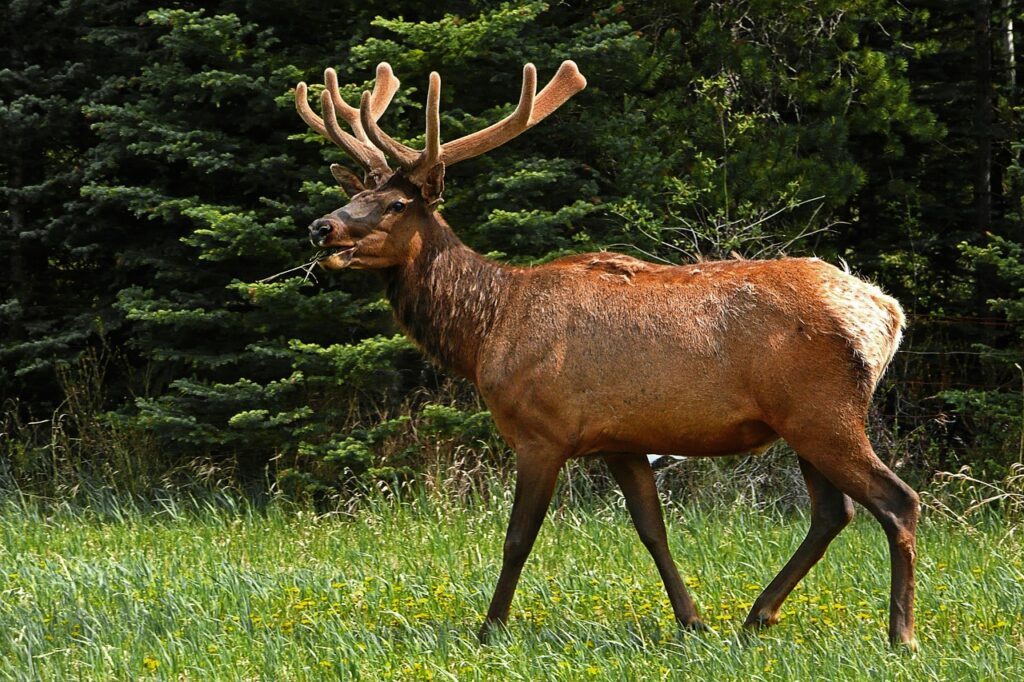When it comes to wildlife in the Smoky Mountains, few creatures captivate the imagination quite like the majestic elk. In this article, we will delve into the world of these magnificent animals, providing you with a comprehensive overview of their species, habitat, behavior, and ecological significance. Join me as we explore the enchanting realm of the elk in the Smoky Mountains.When it comes to wildlife in the Smoky Mountains, few creatures captivate the imagination quite like the majestic elk. In this article, we will delve into the world of these magnificent animals, providing you with a comprehensive overview of their species, habitat, behavior, and ecological significance. Join me as we explore the enchanting realm of the elk in the Smoky Mountains.
The Elk Species in the Smoky Mountains
The Smoky Mountains are home to a distinct subspecies of elk known as the Rocky Mountain elk (Cervus canadensis nelsoni). These magnificent creatures are the largest members of the deer family, boasting impressive antlers and a robust build. Their reddish-brown coats, lighter in color during the summer and darker in winter, make them easily recognizable amidst the mountainous landscape.
Physical Characteristics and Distinguishing Features
Rocky Mountain elk have several distinguishing features. Adult males, known as bulls, can reach heights of up to five feet at the shoulder and weigh over 700 pounds. Their antlers, which can grow up to four feet long, are shed and regrown each year. Female elk, or cows, are smaller in size and lack antlers.

Historical Background of Elk Population in the Region
Elk were once abundant throughout the Smoky Mountains but faced a severe decline in the early 20th century due to overhunting and habitat loss. Thanks to successful conservation efforts, elk were reintroduced to the area in the early 2000s. Since then, the population has thrived, offering visitors the opportunity to witness these magnificent creatures in their natural habitat.
Habitat and Range
Elk in the Smoky Mountains prefer habitats that provide a mix of open meadows, grasslands, and forested areas. They can be found in various zones within the national park, such as Cataloochee Valley, Oconaluftee, and Cades Cove. Key factors influencing their habitat selection include access to water sources, food availability, and suitable cover for protection.
Life Cycle and Behavior
Elk’s Life Cycle Stages
An elk’s life cycle begins with birth, typically in late spring or early summer. Calves, with their characteristic light-colored spots, spend their first few weeks hidden in dense vegetation. As they mature, they join larger groups called harems, led by a dominant bull. By their second year, young males venture out on their own, while females remain within the harem until they are ready to breed.
Seasonal Behavior Patterns
One of the most fascinating aspects of elk behavior is their annual rutting season. During this time, which usually occurs in the fall, dominant bulls engage in intense battles for mating rights. Their resonating bugling calls echo through the mountains as they assert their dominance and attract females. Elk also undertake seasonal migrations, moving to lower elevations during winter months in search of food.
Social Structure and Communication
Elk are highly social animals and form intricate hierarchies within their herds. The dominant bull leads the harem, consisting of several females and their offspring. Communication among elk is primarily through vocalizations, such as bugling, barking, and mewing, as well as body language and scent marking.
Ecological Significance
Elk play a vital role in the Smoky Mountains ecosystem. As herbivores, they help shape the landscape by browsing on a variety of plant species, which in turn influences plant growth and distribution. By selectively grazing on certain plants, elk can create more diverse vegetation communities, benefiting other herbivores and promoting overall biodiversity in the region.
Furthermore, elk act as important seed dispersers. As they move through the landscape, seeds from the plants they consume are excreted, contributing to the dispersal and germination of various plant species. This process helps maintain the health and diversity of plant communities in the Smoky Mountains.
The presence of elk also has cascading effects on other wildlife. Their grazing patterns can create open areas that provide habitat for smaller mammals, birds, and insects. Additionally, the large amount of herbaceous vegetation consumed by elk supports a diverse array of invertebrates, which in turn serve as a crucial food source for other animals higher up the food chain.
In summary, elk play a crucial role in maintaining the ecological balance of the Smoky Mountains. Their browsing behavior, seed dispersal, and influence on vegetation communities contribute to the overall health and biodiversity of the region’s ecosystem.
Elk Conservation Efforts
Conservation initiatives aimed at protecting elk in the Smoky Mountains have been instrumental in the recovery and preservation of their population. Collaborative efforts between national park authorities, wildlife organizations, and local communities have played a significant role in these efforts.
Strategies for elk conservation include habitat restoration and management, monitoring and research programs, and public education and outreach. By restoring and maintaining suitable habitats, providing protection from poaching and illegal activities, and conducting research to better understand elk populations and their needs, conservationists strive to ensure the long-term survival of these majestic creatures.
Thanks to these conservation efforts, the elk population in the Smoky Mountains has rebounded, offering visitors a unique opportunity to witness these magnificent animals in their natural habitat.
Best Practices for Elk Viewing
If you’re eager to observe elk in the Smoky Mountains, here are some essential tips to enhance your wildlife viewing experience:
1. Timing and Season
Plan your visit during the early morning or late afternoon when elk are most active. Rutting season, which typically occurs in the fall, offers a higher chance of witnessing dramatic displays of dominance.
2. Recommended Viewing Spots
Popular areas for elk sightings include Cataloochee Valley, Oconaluftee, and Cades Cove. These locations offer open meadows and grasslands where elk often gather.
3. Respect Wildlife Boundaries
Observe elk from a safe distance, using binoculars or a camera with a zoom lens to avoid disturbing them or encroaching on their space. Remember, they are wild animals, and their behavior can be unpredictable.
4. Quiet and Patience
Keep noise to a minimum and be patient. Elk are wary creatures and may retreat if they sense any threat or disturbance. Give them space and time to feel comfortable in your presence.
5. Follow Park Regulations
Always adhere to park regulations and guidelines regarding wildlife viewing. These rules are in place to protect both the animals and visitors.
Photography Tips for Capturing Elk in the Smoky Mountains
If you’re interested in capturing stunning photographs of elk, here are some practical tips to help you make the most of your photography experience:
1. Equipment
Use a DSLR or mirrorless camera with a telephoto lens to capture detailed shots from a distance.
2. Camera Settings
Set your camera to a fast shutter speed to freeze the elk’s movements and capture sharp images. Use a wide aperture (low f-stop value) to create a shallow depth of field, isolating the elk from the background and emphasizing their features.
3. Composition
Experiment with different compositions to create visually appealing photographs. Consider the rule of thirds and place the elk off-center for a more dynamic composition. Use natural elements like trees or mountains as frames or leading lines to add depth and interest to your shots.
4. Lighting
Take advantage of the golden hours—the first hour after sunrise and the last hour before sunset—when the light is soft and warm. This lighting condition can enhance the colors and textures of the elk and the surrounding landscape. Avoid shooting in harsh midday sunlight, as it can create harsh shadows and wash out the details.
5. Ethical Considerations
Respect the elk and their natural behavior. Do not disrupt their activities or interfere with their movements. Remember to prioritize the welfare of the animals over getting the perfect shot.
FAQs
What is the best time of year to visit the Smoky Mountains?
The best time to see elk in the Smoky Mountains is during the fall rutting season, which typically occurs from September to October. During this time, bull elk engage in impressive displays of dominance, bugling calls, and herding behavior. However, elk can be seen throughout the year in various locations within the national park.
Can I feed or approach elk in the Smoky Mountains?
No, it is strictly prohibited to feed or approach elk in the Smoky Mountains. Feeding wildlife can disrupt their natural diet and behavior, and approaching them can be dangerous for both you and the animals. It is important to maintain a safe distance and observe them from afar, allowing them to remain undisturbed in their natural habitat.
Are elk dangerous?
No, elk generally avoid human contact and are not inherently aggressive. However, they are still wild animals and should be observed from a safe distance. It is important to respect their space and not approach or disturb them, especially during the rutting season when bull elk can be more territorial and protective.
Are there any guided tours or programs for elk viewing in the Smoky Mountains?
Yes, the Smoky Mountains National Park offers guided programs and ranger-led tours focused on elk viewing and wildlife observation. These programs provide valuable insights into elk behavior, habitat, and conservation efforts. Check the park’s official website or visitor centers for information on available programs and guided tours.
Can I camp or stay overnight near elk habitats?
Yes, camping is allowed in designated campgrounds within the Smoky Mountains National Park. However, it is important to choose a campground away from elk habitats to minimize any potential conflicts or disturbances. Follow the park’s guidelines for camping and be mindful of the need to maintain a safe distance from wildlife at all times.
What should I do if I encounter an elk while hiking or exploring the Smoky Mountains?
If you encounter an elk while hiking or exploring the Smoky Mountains, it is important to remain calm and maintain a safe distance. Keep at least 50 yards (about 45 meters) away from elk and do not attempt to approach them. If an elk approaches you, slowly back away while maintaining eye contact. It is important not to turn your back on the animal or run, as this may trigger a chase response. Remember, your safety and the well-being of the elk are of utmost importance.
Are there any restrictions on capturing or interacting with elk for photography purposes?
Yes, it is essential to adhere to ethical guidelines and respect wildlife when photographing elk. Do not disturb or disrupt their natural behavior for the sake of capturing a photograph. It is important to maintain a safe distance and use zoom lenses or binoculars to observe them closely. Refrain from using artificial calls or attempting to lure elk closer for photography purposes. Prioritize the well-being of the animals and their natural environment over capturing the perfect shot.
Are there any other notable wildlife species in the Smoky Mountains?
Yes, the Smoky Mountains are home to a diverse range of wildlife species. In addition to elk, you may encounter black bears, white-tailed deer, wild turkeys, bobcats, coyotes, and a variety of bird species. The park’s rich biodiversity offers ample opportunities for wildlife observation and appreciation.
Are there any ongoing conservation efforts for elk in the Smoky Mountains?
Yes, various conservation initiatives are in place to protect elk populations in the Smoky Mountains. These efforts involve collaboration between national park authorities, wildlife organizations, and local communities. Conservation programs focus on habitat restoration, population monitoring, research, and public education to ensure the long-term survival and well-being of elk and their ecosystems.
Can I report any elk sightings or unusual behavior to park authorities?
Yes, if you have any notable elk sightings or observe unusual behavior, it is encouraged to report these observations to park authorities. This information can contribute to ongoing research and monitoring efforts, helping park officials make informed decisions regarding elk management and conservation.
Conclusion
The elk of the Smoky Mountains are not only a symbol of natural beauty but also integral to the delicate ecosystem of the region. By understanding their species, habitat, behavior, and ecological significance, we can develop a deeper appreciation for these majestic creatures and the importance of their conservation.
Through collaborative conservation efforts, elk populations have rebounded in the Smoky Mountains, allowing visitors the opportunity to witness these remarkable animals in their natural environment. By following best practices for elk viewing and photography, we can enjoy their presence while ensuring their well-being and the preservation of their habitats.
So, grab your camera and venture into the enchanting world of the elk in the Smoky Mountains. Immerse yourself in their captivating presence, and let their majestic beauty leave an indelible mark on your heart and soul.





Leave a Reply